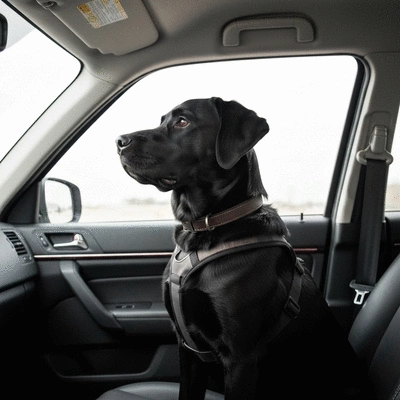Comfort Considerations
- Anxious Dogs: Padded, snug fit for security.
- Active Dogs: Allows movement without sacrificing restraint.
- Reduced Anxiety: Comfortable harnesses soothe pets.

What if the safety of your furry friend depended on the simple decision of selecting the right seat belt? This choice can influence not just their security, but their comfort as well during travels.
The decision to choose a dog seat belt involves carefully weighing comfort against safety. This visual highlights the key aspects to consider for an optimal travel experience for your pet.
Choosing the right dog seat belt involves a critical balance between comfort and safety. This is especially true for our furry companions who may be anxious or active during car rides. As a passionate pet advocate, I understand how vital it is to select a restraint system that ensures our beloved dogs are both secure and comfortable. After all, a stressed-out pup can lead to an equally stressed-out driver!
When evaluating dog seat belts, consider the unique temperament of your dog. An anxious dog might need a more padded, snug fit to feel secure, while an active dog may benefit from a harness that allows for some wiggle room without sacrificing safety. The right balance establishes a safe and enjoyable travel experience for both you and your pet.

Dogs, just like humans, have distinct personalities that can greatly influence their comfort during travel. For instance, an anxious dog may respond well to a harness that provides extra support, while an active dog might prefer a seat belt that allows them to move around yet still feel restrained. Here are some key reasons why both comfort and safety are crucial:
In essence, understanding your dog's needs can significantly impact their behavior during car rides. The right dog seat belt not only keeps them safe but also contributes to a stress-free journey!
When searching for the ideal dog seat belt, certain features should be at the forefront of your decision-making process. Here are some essential characteristics to consider:
By focusing on these key features, you can confidently choose a seat belt that prioritizes your dog's safety and comfort. Remember, a well-made seat belt is an investment in your pet's well-being during every journey!
Understanding dog safety ratings is essential in making informed choices about seat belts. These ratings assess how well a product performs under various conditions and are often derived from rigorous testing standards. Here’s why they matter:
At Dog Seat Belts, we believe that understanding these ratings can empower pet owners to make smart choices. After all, ensuring your dog's safety while on the road is our top priority!
What do you think about the importance of comfort versus safety in dog seat belts? Share your thoughts below:
As we wrap up our discussion on the balance between comfort and safety in dog seat belts, it's crucial to remember that both aspects play a significant role in ensuring your furry friend is secure and content during car rides. Choosing the right seat belt isn't just about compliance with safety regulations; it's also about making sure your dog feels at ease. Here are some key takeaways to help you make an informed decision:
Remember, finding the ideal dog seat belt means considering both comfort and safety, especially for dogs with specific behavioral needs. This dual focus will ensure that every journey is not just safe, but also enjoyable for your pet!
Now that we've explored the nuances of comfort and safety, it's time to take action! When selecting the best dog seat belt for your pet, here are a few steps you can follow:
Don't hesitate to make a choice that aligns with your dog’s specific needs. A well-chosen seat belt not only enhances safety but also contributes to a stress-free travel experience. Let's keep those tails wagging and enjoy the journey together!

Here is a quick recap of the important points discussed in the article:
Dedicated to enhancing pet safety during car travel, we provide comprehensive reviews, installation guides, and essential tips for responsible pet owners. Join us in making every journey safe and enjoyable for your furry friend.
